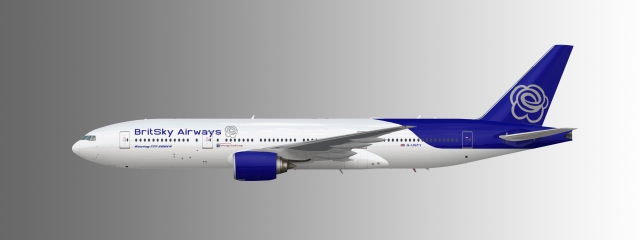Boeing 777-200ER BritSky
- Owner: Rigel (View all images and albums)
- Uploaded: Sep 10 2020 10:26 AM
- Taken: 2020:09:10 20:26:00
- Views: 924
- Album ZYX - Brands By Rigel
Template by Med. Logo and livery by Rigel

Part 3 of the BritSky story!
By the early 2000s, BritSky's long haul operations were expanding rapidly. Their fleet of 767-300ERs and 767-400ERs were making regular trips across the Atlantic to places such as Toronto, New York, Montreal, Washington D.C., Dallas, and for the first time, Rio de Janeiro. However, the 767s were beginning to seem quite small for their missions. The New York route, for example, was effortlessly filling up four 767-400ERs, and could easily fill up more. The 767s were flying at capacity, eight times a day, every day of the week, and that was still not enough. A larger aircraft was needed, one that could reduce the stress of the 767s, and have the range to potentially open up new destinations, on the east coast of the USA.
In 2005, BritSky's founder and CEO, John Truscot, made his choice. Having chose pretty much only Boeing for his long-haul fleet, he had decided on the Boeing 777 as his new long-haul vessel, and placed an order for 8 777-200ERs, to be powered by Rolls Royce Trent 800. After comparing the stats against the Airbus A330 and A340, Truscot chose the 777 after deciding that the A330 wasn't big enough, and the A340 wasn't efficient enough. Plus, the 777 maintained fleet commonality with the 767, meaning no significant amounts of new pilot training was needed to fly the new plane.
The first BritSky 777 touched down at London Gatwick on January 29, 2007. It was a big event, and thousands of spectators, including CEO Truscot himself, attended and showed up to watch the new plane touch down. After the event and a guided tour showcasing the aircraft and its features, the plane took off on February 2nd, bound for New York.
The Boeing 777 proved to be an excellent plane in the BritSky operations, reducing the load on the 767s. The plane was regularly used on the highest-density routes to the United States and Canada, leaving South America and the lower-demand US routes to the 767 fleet. The 777 also inaugurated the airline's first route to Los Angeles. Truscot was still charging lower fares than the competition, and demand was still growing. BritSky's future was looking bright.
However, 2010 saw the first sign of trouble for the airline. On June 10th, while sitting in his office, Truscot had started experiencing chest pains. A colleague drove him to the nearest hospital, and an hour later, Truscot suffered an enormous heart attack, and died. BritSky now had no CEO, and management fell into disarray. While management scrambled to find a replacement, the airline ground to a halt. Operations stopped, and the planes just sat on the ground at the airports they were at.
By July 2010, BritSky had found someone who would take over as CEO of the company. 52-year-old William Marret took the reigns of the company, and operations officially restarted. The first destination operated by the 777 under the new CEO was Dallas. However, Marret didn't operate the company in the same way as Truscot; He was a lot more serious, and didn't really care about the company he was running. Therefore, the employees of the company didn't feel as connected to the airline as they did under Truscot's management, and the services from the company took a dive as a result.
Part 4 will come soon!
Shown above is G-USTY, one of the airline's last 777-200ERs, in a "what-if" of the 2015 livery. This is a what-if because the 777 never actually saw this livery; The entire 777 fleet was sold off to other airlines before the livery was introduced, as it interfered with Sovereign Airways' operations. The 777 fleet had eventually grown to 16 units by 2015. Unfortunately, this 777 was one of the few that wasn't introduced into the Sovereign Airways fleet; After sitting at London for 2 months, it was eventually bought by Borealia Canadian Airways.
Leave feedback! Any and all feedback helps (but preferably constructive).

 Sign In
Sign In Create Account
Create Account











